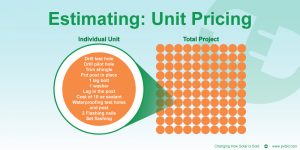This week we start streamlining the art. As a method with nearly equivalent accuracy as Take-offs, unit pricing adds speed. It uses the same principles of Take-offs at a slightly bigger picture. Well, from a different angle. Basically, you identify something that is repeated, group all of the related tasks and make them a unit (enter the term Unit pricing). The unit concept can vary in size, too.
Think Legos. When you build your Lego race car from a kit, you are building it with a bunch of units. Lego could have provided only flat 1×1 and flat 1×2 pieces. But can you imagine building an entire race car out of just those?! Instead, they created different units. A flat 1×10 or a standard 1×2 which is 3 flat 1×2 stacked as an equivalent. Perhaps you already thought of this concept when you were reading last week’s article on take-offs. You do the take-offs for the specific thing that you are using in your unit pricing, and then multiply that result by the number of that thing.
In the solar world, a typical unit is the standoff or post. For our example, you are installing 10 posts on a comp shingle roof. The post installation is made up of a series of steps:
- Drill the test hole
- Drill the pilot hole
- Trim the shingle
- Put the post in place
- 1 lag bolt
- 1 washer
- Lag in the post
- Cost of 10 oz sealant
- Waterproofing test holes and post
- 2 Flashing nails
- Set the flashing
 That works out to about (for purposes of this example) 4 minutes per post to put in place plus $15 in materials. Multiply that by 10 posts means my team will spend 40 minutes and $150 installing posts. The catch: It’s really easy to create a unit and then forget about things like setup time or efficiency with repetition. Following the example above, the material costs might stay the same for a larger-than-10-post project but the labor is probably going to be less than 4 minutes per post. On each project, I must determine how long it will take for the team to start installing the posts.
That works out to about (for purposes of this example) 4 minutes per post to put in place plus $15 in materials. Multiply that by 10 posts means my team will spend 40 minutes and $150 installing posts. The catch: It’s really easy to create a unit and then forget about things like setup time or efficiency with repetition. Following the example above, the material costs might stay the same for a larger-than-10-post project but the labor is probably going to be less than 4 minutes per post. On each project, I must determine how long it will take for the team to start installing the posts.
This one-time take-off method of creating units allows you to move faster not only on this project, but any future project. By creating assemblies of parts and labor that you keep in reserve, things you have already figured out in advance or you figure out on the fly, bids can be faster each time you use the unit again in the future.
One Step Further
We could create a unit that is an entire system, say a 24 kW ground mount array. We could then stamp it out 100 times to have a 2.4 MW ground mount system with a relatively accurate price. The only part left that we must work out is the wiring from the inverters to the load centers and the interconnection. That’s a whole lot easier for a quick turnaround than working out all 5,400 tasks of “set steel post in form”, 5,400 tasks of “pour concrete”, 60,000 feet of racking, each individual string wiring, and the wiring from each inverter to the load centers and the interconnection!

